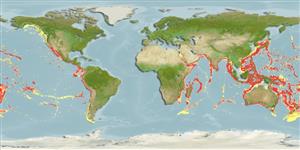Cephalopoda |
Octopoda |
Amphitretidae
Environment: milieu / climate zone / গভীরতার পরিসীমা / distribution range
বাস্তুসংস্থান
ভাসমান; গভীরতার পরিসীমা 100 - 2000 m (সূত্র 96968). Tropical
Indo-Pacific. Tropical to subtropical.
Length at first maturity / আকৃতি / Weight / Age
পরিপক্কতা : Lm ? range ? - ? cm Max length : 30.0 cm TL পুরুষ/ লিঙ্গ অনিধর্ারিত ; (সূত্র 96968)
Mantle length is 10 cm (Ref. 96968). The upward orientation of the telescopic eyes is used for prey detection. Juveniles appear to occur in shallower water (Ref. 96968). Rare but seen in mangroves (Ref. 101170).
Life cycle and mating behavior
পরিপক্কতা | প্রজনন | ডিম ছাড়া | Eggs | ডিম্বধারন ক্ষমতা | Larvae
Members of the class Cephalopoda are gonochoric. Male and female adults usually die shortly after spawning and brooding, respectively. Mating behavior: Males perform various displays to attract potential females for copulation. During copulation, male grasp the female and inserts the hectocotylus into the female's mantle cavity where fertilization usually occurs. Life cycle: Embryos hatch into planktonic stage and live for some time before they grow larger and take up a benthic existence as adults.
Norman, M.D. and C.C. Lu 2000 Preliminary checklist of the cephalopods of the South China Sea. The Raffles Bulletin of Zoology 8:539-567. (সূত্র 81752)
IUCN Red List Status
(সূত্র 130435: Version 2025-1)
CITES status (সূত্র 108899)
Not Evaluated
Not Evaluated
Threat to humans
Human uses
| FishSource |
হাতিয়ার
আরো তথ্য
ট্রফিক বাস্তুতন্ত্র Food items (preys)
পথ্য উপাদান
খাদ্য গ্রহণ
শিকারী প্রাণী সমূহ
Population dynamicsবৃদ্ধিMax. ages / sizesLength-weight rel.Length-length rel.Length-frequenciesMass conversionপ্রাচুর্য Life cycleপ্রজনন পরিপক্কতা ডিম্বধারন ক্ষমতা ডিম ছাড়া EggsEgg developmentLarvae Physiologyঅম্লজান ব্যবহার
Human RelatedStamps, coins, misc.
ইন্টারনেট সুত্র
Estimates based on models
Preferred temperature
(Ref.
115969): 4.8 - 12.6, mean 8 (based on 1137 cells).
Fishing Vulnerability
Low vulnerability (20 of 100).
Price category
Unknown.
